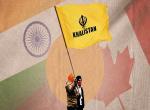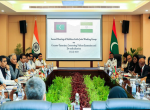There is a growing debate whether the Islamic State of Iraq and Syria (ISIS) will advance into the heartland of Central Asia or not, although the figures of people from the region joining the outfit differ from source to source. But considering the prevailing situation in most of these countries, even a few hundreds could be a worrying number. The rise in radicalism gained momentum after the demise of the Soviet Union in 1991. Reportedly, in the past three years, approximately 2,000 to 4,0001 people started to seek a radical path as an alternative to the systems provided by their respective governments. This emerging trend fits well into that ambition of the ISIS to spread its tentacles globally.
The appearance of the black flag of the ISIS on a bridge in Tashkent on 28 August last year became one of the earliest incidents which marked the penetration of ISIS influence in this country. Thereafter, the outfit announced the appointment of an “emir” for Uzbekistan, whose identity has not been revealed,2 and this was followed by another appointment of an emir for Raqqa, which is the headquarters of the group. Thereafter, the Islamic Movement of Uzbekistan (IMU), under the leadership of Usman Gazi, extended support to Abu Bakr al-Baghdadi in mid-September 2014.3 This group is believed to have close relations with al-Qaeda and Taliban, but some of its cadres “had been thrown out over ideological differences or for insubordination.”4 However, IMU’s similar vision to establish a caliphate took it closer to ISIS without even declaring an outright allegiance to the latter. If both the groups merge someday, then the IMU will likely assist ISIS in staging more attacks in northern Afghanistan as well as in different parts of Central Asia.5
The resentment of the people with regard to political system in their respective countries can be attributed for the rise of religious extremism, which is tilting in favour of the ISIS. The power vacuum that was created after the fall of the Soviet Union led to the strengthening of radical elements in the region, and the mushrooming of several Islamists groups in the 1990s in Tajikistan is one such case. The governance of authoritarian rulers in Uzbekistan and Turkmenistan, and equally corrupted political systems in Kyrgyzstan and Tajikistan have driven many of the residents to call for “radical Islamism.”6 Similar is the situation in Kazakhstan, a country with vast oil and gas reserves, where there is an autocratic rule and rural population living in poverty. When these people feel they are economically or politically marginalised, they resort to violence, which, as a result, received crackdown form the state forces. This further estranged the relationship between them, and leads to the growth of radicalism.
Various sources have given different figures of Central Asians who have joined ISIS fighters. According to the International Centre for Study of Radicalisation and Political Violence (ICSR)7, there are at least 250 Kazakh fighters in the ISIS, 100 Kyrgyz citizens (while another source talks of as many as 600 fighters8), 360 from Turkmenistan, 500-odd Uzbek fighters (both citizens of Uzbekistan and ethnic Uzbeks from the neighbouring countries), and for Tajikistan, the figure ranges between 400 and 2,000.9 The movement of these people has become easier due to the 30-days visa-free regime with Turkey. In some cases, Afghanistan is an alternative but this is a less used route.
Factors
The radicalisation process which began in the early 1990s played an important role in making people move towards Syria, today. However, it is difficult to pick out any particular motive for Central Asians to join ISIS ranks, but “some are driven by the spirit of jihad, while others may be drawn to it due to ignorance and bigotry. The search for the employment and earnings remains one of the main factors”.10 Moreover, the belief of these people that ISIS can provide better prospects somehow facilitates the departure. A study conducted by the International Crisis Group (ICG) sums up that “All are inspired by the belief that an Islamic state is a meaningful alternative to post-Soviet life. Some wish to fight, others to facilitate.”11
Wide-ranging socio-economic problems in most of the Central Asian countries have induced a strong sense of dissent against the state authorities. Such dissatisfaction which exists within a society, with a sizeable radicalised people, is a prime target for the group’s recruitment process. Therefore, those without employments or with a very insignificant salary become highly vulnerable to various terror outfits operating in the region, not only the ISIS. There were even reports of leaflets circulated by the ISIS in Tajikistan “offering Tajik fighters salaries of $5,000 a month, far more than the average salary” in the country.12
In the words of P. Stobdan, a former diplomat:
They [Uzbeks, Tajiks and Kyrgyz] are often tricked into the jihadi net by unscrupulous recruiters who promise them jobs in Turkey and Europe. One reason why Central Asian fighters find lucrative to rush to Middle East than to Af-Pak region, is because they find ISIS more inspirational, prestigious, and rewarding than fighting in Af-Pak region. Moreover, Central Asians are never empathetic towards the Af-Pak Taliban for they pose direct threat to the region. They perhaps find other reasons like better living standards (permission to bring family, permission to marry local women) to go to Syria. It is also less hazardous to reach Syria than Af-Pak as Turkey provides easy gateway. All the Central Asian States have favorable visa regime with Turkey.13
The adherence to the extreme religious ideologies propagated by terror outfits such as ISIS is another strong reason for the flights of young men and women to Syria, in particular. The ambition to create an Islamic state wherever possible appears to have takers in this part of Asia. Under such circumstances, the contributions of the volunteers need only concentrate on battle fights but they are willing to provide humanitarian assistance. Therefore, their profiles are varied and they are mainly constituted of schools and university dropouts, businessmen, women abandoned by their husbands, etc.14 This comes in conjunction with that call on Muslims, by al-Baghdadi in July 2014, to travel to Iraq and Syria to lend helping hand in the establishment of an Islamic state. “Special calls” were made for “judges, doctors, engineers and people with military and administrative.”15 And, for the jihadists and religious ideologues, setting up of such a state, which is to be governed by strict Islamic laws, have become a commonly shared goal with that of ISIS.
Recruitment
Although social media remains as a pivotal instrument, it is not the most important recruiting strategy. The numbers of people having access to internet are low in many places in the region. While this tool acts as a communicating bridge between fighters in Iraq or Syria and those aspiring jihadist in Central Asia, the role of local institutions such as mosques and places of religious learning are equally gaining momentum. Influential religious leaders are believed to have assisted in radicalising the citizens who are susceptible to their preaching. For instance, radical groups such as Hizb-ut-Tahrir, which has strongholds in the region, particularly in Uzbekistan,16 and Tabligi Jamaat are reportedly playing a “peripheral role in so far as both men and women may be radicalised as they gravitate toward their teachings.”17 But the links to their direct involvement in recruiting Central Asians have remained limited, whereas some members of the IMU are believed to have done this job for ISIS in the Fergana Valley comprising of Kyrgyzstan, Tajikistan and Uzbekistan.
The close proximity of Central Asian countries to Russia is also serving as a conduit for recruitment. This is due to the migration of workers towards Russian towns and cities in search of employment, particularly in the constructions sites. Several workers are said to have travelled to Syria after they were recruited by “Chechens in Moscow.”18 Tajik fighters constitute a majority of the migrant recruits. However, the identities of these “Chechens” recruiters are vague, but some of them are probably from the Pankisi George region in Georgia,19 the hometown of the "Omar the Chechen”, also known as Omar Ash-Shishani, the Islamic State military commander who was allegedly killed in November last year. 20 The availability of online forums in Russian and other local languages make the recruitment endeavours easier. It is perhaps with this motive ISIS released first Russian-language publication called “Furat.Press” in May, and the second one, Istok (The Source) in June this year.21
The increasing activity of recruitment inside Russia takes place amidst the efforts to curb the issue of religious extremism. This phenomenon is prevalent in Moscow, which has perhaps the largest Muslim concentration in the country. While some of them get access to Mosques, which is limited in numbers, there are others who use temporary or “inappropriate” buildings for prayers. This, according to a source, “Prompts the police and the security services to regard them as sectarians and adherents to unofficial Islam, which automatically puts them in the category of potential terrorists.”22 As a result, dissatisfaction with the government and the role of law enforcement authorities has promoted the growth of radicalism. Finally, these disgruntled people have become the target for the recruiters.
Concerns and Countermeasures
The influence of ISIS inside Central Asia is taken to be dormant by many. There is an impression that the group is still far away from making inroads in the region. But these presumptions must not lead the countries to complacency. The developments in its immediate neighbourhoods, that is, inside Russia (as recruitment zone) and Afghanistan, where ISIS announced the establishment of its Khorasan wing (covering Pakistan as well) during late January 2015, are alarming. Moscow will not like to see an increase in the number of recruits on its soil (who then travel towards West Asian region) as there is always the possibility of those fighters returning home. These fighters can be source of strengths for other terror organisations inside the country as well. Moreover, the returnees can ignite unrest or influence like-minded people in their native countries. Equally worrying trend is developing in Afghanistan where limited group of fighters are spreading in the eastern part of the country. Although ISIS presence is still insignificant in Afghanistan, it is increasingly attracting new recruits, particularly, the dissatisfied or disillusioned former Taliban commanders.23 Therefore, It is possible that the ISIS will carry forwards its fights towards Central Asia after establishing a sustainable presence in the Af-Pak region.
Since security measures alone cannot prevent the deepening of extremism in the region, there should be civilian approaches as well. The latter will require improving the overall socio-economic and political situation in every country. But for all these to materialise, a strong political will and resources are required. This is where the role of the affluent international powers will become appropriate, beyond providing military assistance. And, to prevent the upsurge of radical elements and that of the ISIS, the need of the hour is for the Central Asian countries to start engaging constantly amongst themselves. A robust regional cooperation framework in military-intelligence sharing should be established.
Since Central Asia is India’s extended neighbourhood, New Delhi should step up its cooperation with the countries there. Owing to its strategic interests in this region with abundance of natural resources, the current visit of Prime Minister Narendra Modi to the five states should give equal importance in discussing the long-term security implications, particularly, counter-terrorism, beyond oil and energy trade. This is an opportune moment for India in particular, keeping in mind the development of Chabahar port in Iran, a Persian Gulf country which it will use as a transit for Central Asia.
Finally, the efforts to prevent the ISIS from making Central Asia as its stop in the future will flounder if the countries in and around the region fail to understand the gravity of the situation. The vigour of this organisation should never be underestimated.
Endnotes
- “Syria Calling: Radicalisation in Central Asia”, Policy Briefing, No. 72, Europe and Central Asia, International Crisis Group, 20 January 2015, p. 1.
- “Islamic State Flag Hung from Tashkent Bridge”, Radio Free Europe Radio Liberty, 4 September 2014, http://www.rferl.org/content/uzbekistan-islamic-state-flag-tajikistan-syria-iraq/26565807.html
- “Islamic Movement of Uzbekistan declares support for ISIS”, alakhbar, 6 October 2014, http://english.al-akhbar.com/content/islamic-movement-uzbekistan-declare-support-isis
- Joseph Goldstein, “In ISIS, the Taliban Face an Insurgent Threat of Their Own”, The New York Times, 4 June 2015, http://www.nytimes.com/2015/06/05/world/asia/afghanistan-taliban-face-insurgent-threat-from-isis.html?_r=0
- Damon A. Mehl, “The Islamic Movement of Uzbekistan Opens a Door to the Islamic State”, CTC Sentinel, Vol. 8, Issue. 6, pp. 11, 13-14.
- Reid Standish. “Shadow Boxing with the Islamic State in Central Asia”, Foreign Policy, 6 February 2015, http://foreignpolicy.com/2015/02/06/shadow-boxing-with-the-islamic-state-in-central-asia-isis-terrorism/
- Peter R. Neumann, “Foreign fighter total in Syria/Iraq now exceeds 20,000; surpasses Afghanistan conflict in the 1980s”, International Centre for Study of Radicalisation and Political Violence, 26 January 2015, http://icsr.info/2015/01/foreign-fighter-total-syriairaq-now-exceeds-20000-surpasses-afghanistan-conflict-1980s/
- Anna Dyner, et al, “Ready to Go? ISIS and Its Presumed Expansion into Central Asia”, Policy Paper, No. 19 (121), The Polish Institute for International Affairs, June, p. 6.
- Ibid., p. 7.
- P. Stobdan, “ISIS in Central Asia”, IDSA Issue Brief, 22 October 2014, http://www.idsa.in/issuebrief/ISISinCentralAsia_pstobdan_221014.html, p. 4.
- “Syria Calling: Radicalisation in Central Asia”, p. 4.
- Shawn Snow, “ISIS Looks for Foothold in Central Asia”, The Diplomat, 18 January 2015, http://thediplomat.com/2015/01/isis-looks-for-foothold-in-central-asia/
- Stobdan, “ISIS in Central Asia”.
- “Syria Calling: Radicalisation in Central Asia”, p. 4.
- “Isis leader calls on Muslims to ‘build Islamic state’, BBC, 1 July 2014, http://www.bbc.com/news/world-middle-east-28116846
- Samantha Brletich, “Central Asia: Hizb-ut-Tahrir on the Rise”, International Relations and Security Network, 8 August 2008, http://www.isn.ethz.ch/Digital-Library/Articles/Detail/?id=88668
- “Syria Calling: Radicalisation in Central Asia”, p. 6.
- For a brief report, see Daniil Turovsky, “How Isis is recruiting migrant workers in Moscow to join the fighting in Syria”, The Guardian , 5 May 2015, http://www.theguardian.com/world/2015/may/05/isis-russia-syria-islamic-extremism
- Ibid.
- “ISIS commander 'Omar the Chechen' allegedly killed”, RT, 13 November 2014, http://rt.com/news/205239-russia-chechen-isis-killed/
- Umberto Bacchi, “Isis targets jihadists in former Soviet nations with Russian-language propaganda magazine Istok”, International Business Times, 3 June 2015, http://www.ibtimes.co.uk/isis-targets-jihadists-former-soviet-nations-russian-language-propaganda-magazine-istok-1504238
- Mairbek Vatchagaev, “Moscow Remains Fertile Recruiting Ground for Aspiring Jihadists”, Eurasia Daily Monitor, Vol. 12, Issue. 41, 5 March 2015.
- “Can the Islamic State Defeat the Taliban”, Stratfor, 25 June 2015. For further reading, see Lauren McNally, “Is the Islamic State Escalating in Afghanistan”, Institute for the Study of War, 27 April 2015.
Published Date: 8th July 2015, Image Source: http://www.theguardian.com (Disclaimer: The views and opinions expressed in this article are those of the author and do not necessarily reflect the official policy or position of the Vivekananda International Foundation)










Post new comment